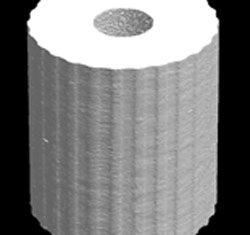
A new technology adopted by Ford Motor Co. promises to eliminate tedious manual inspections of small molded parts and also boost the quality of components produced by the auto maker’s suppliers, a top analyst says.
Similar to equipment used by law enforcement and hospitals, Ford’s Skyscan Micro-CT scanner reveals tiny imperfections in parts that often are invisible to the human eye.
Data gleaned from the scans is provided to suppliers to help them streamline their processes to eliminate future problems.
The scanner “has been very instrumental in identifying reasons why some parts fail,” Vlad Beltran, a Ford lab development analyst, tells Ward’s. “This technology is not available to suppliers, so they’re amazed at what we can find.”
David Andrea, senior vice president-industry analysis and economics for the Original Equipment Suppliers Assn., says the supplier community welcomes such innovations that help ensure quality, as well as save time and money.
“The industry needs real-time solutions between design, engineering and testing to get the most accurate data incorporated into next-generation components,” he tells Ward’s. “This should help reduce up-front engineering and later, warranty costs.”
Similar to a hospital CT scanner, Ford’s device is smaller and the component rotates around the scanner.
The scanner is used on parts such as gears, latches, welds, nuts, bolts, fasteners and sensors before they are assembled into a finished vehicle.

Some flaws revealed in scans include air pockets, indentations and blemishes that can mean the difference between “acceptable and optimal” performance, Beltran says.
“It could be a small part of a latch mechanism in the door or a gear in the HVAC system; a lot of them are plastic,” Beltran says, noting a micron-sized imperfection, smaller than a human hair, can lead to a catastrophic failure.
Prior to the implementation of the scanner, Ford materials analysts painstakingly sanded parts down layer by layer looking for imperfections, a process that was time consuming and ultimately flawed.
“We would sand off the face of the part and polish it, which is several steps,” he says. “Once polished, you would look at it through a microscope, and if you didn’t see anything you’d just continue. Sometimes, you would sand right through (the imperfection).”
Using the data provided by Ford’s CT scans, suppliers now are altering their build parameters in flawed parts, after which the components are returned to the auto maker to be rescanned. “We (then) verify that (problems) have been eliminated,” Beltram says.
The timing for such a device couldn’t be better, Andrea says, given supplier ranks have been decimated by the recession and still are struggling to rebound and keep pace with the auto makers’ slew of new products.
“Given the increased cadence of new product introductions and stretched human resources at OEMs and suppliers, any technology that makes the design and testing interface as seamless as possible is welcome,” he says.




